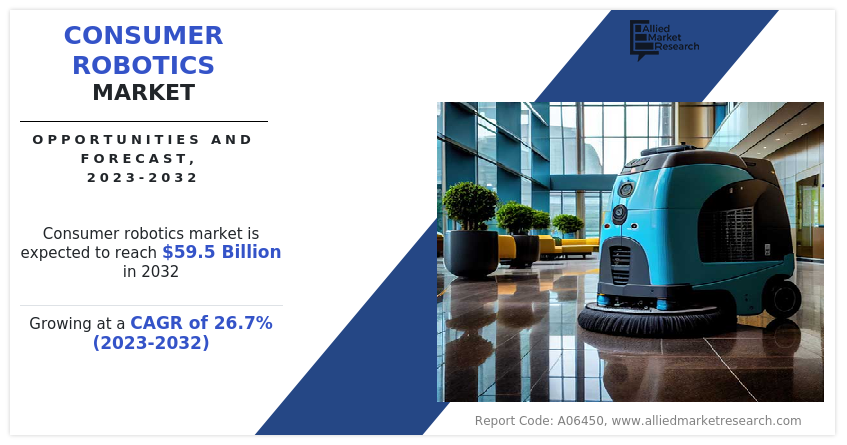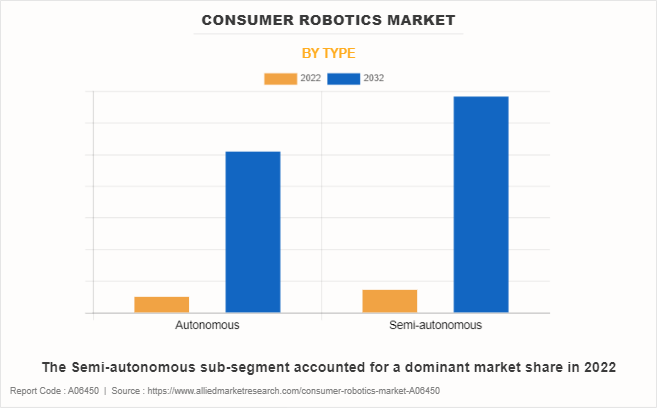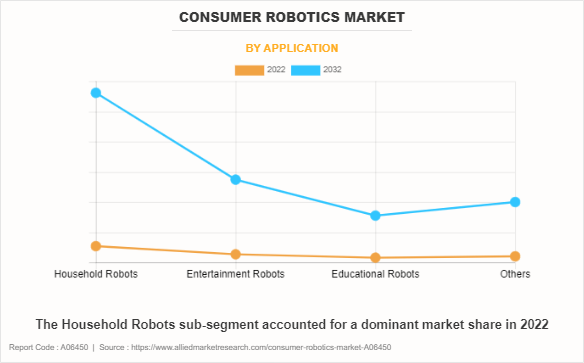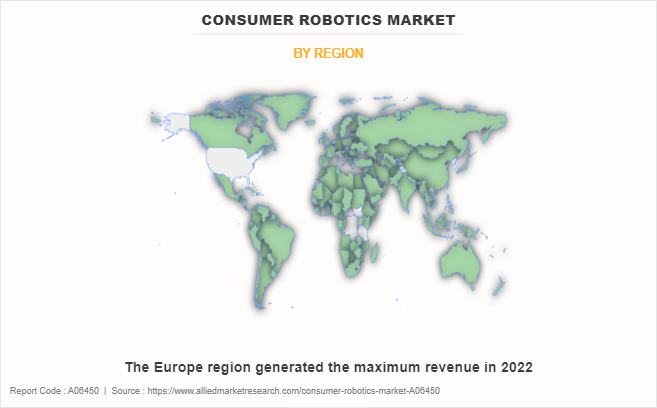Consumer Robotics Market Research, 2032
The global consumer robotics market size was valued at $6 billion in 2022, and is projected to reach $59.5 billion by 2032, growing at a CAGR of 26.7% from 2023 to 2032. Consumer robots are small, easy-to-use robotic systems meant for personal or domestic usage, streamlining numerous tasks to improve daily living. These robots, which are typically portable and simple to use, have become commonplace in homes around the world. Examples range from the commonplace hoover cleaners and floor cleaners to more sophisticated machines capable of activities such as lawn mowing, pool cleaning, and snow removal. Consumer robotics have grown to offer better accuracy and efficiency as technology and engineering continue to advance, presenting itself as a transformational force in modern living.Consumer robots are small, easy-to-use robotic systems meant for personal or domestic usage, streamlining numerous tasks to improve daily living. These robots, which are typically portable and simple to use, have become commonplace in homes around the world. Examples range from the commonplace hoover cleaners and floor cleaners to more sophisticated machines capable of activities such as lawn mowing, pool cleaning, and snow removal. Consumer robotics market demand have grown to offer better accuracy and efficiency as technology and engineering continue to advance, presenting itself as a transformational force in modern living.

Consumer robotics is experiencing a surge in adoption driven by the assurance of cost savings and increased efficiency across various sectors. The past few decades have witnessed a notable increase in the utilization of consumer robots, which offer solutions ranging from industrial automation to household chores like floor cleaning and lawn maintenance. The diverse landscape of consumer robotics is further described into categories such as industrial robots for manufacturing, service robots for everyday assistance, mobile robots for exploration, and autonomous drones for surveillance and delivery. Despite the undeniable potential, challenges such as safety concerns and regulatory compliance remain, requiring thoughtful consideration and resolution. However, the trajectory of the consumer robotics market growth points towards a promising future, with an increasing number of companies exploring innovative ways to integrate these machines into their operations.
The cost associated with consumer robotics remains a key restraint hindering its broader accessibility and adoption. While advancements in technology have led to more affordable robotic devices, certain high-end applications and specialized use cases still demand substantial investments. The initial purchase cost, maintenance expenses, and potential need for upgrades may pose financial challenges for both consumers and businesses looking to integrate these technologies. Overcoming these cost-related barriers requires ongoing efforts to optimize production processes, leverage economies of scale, and drive innovations that lead to more cost-effective solutions, making consumer robotics accessible to a broader audience.
Technological advancements have propelled robots beyond niche applications, turning them into ubiquitous companions in homes and businesses globally. From everyday tasks such as vacuuming and lawn maintenance to more complex roles like personal assistants and healthcare support, robots are rapidly establishing themselves as indispensable contributors to daily life. A key frontier for the consumer robotics market lies in the home, where the convergence of smart homes and the Internet of Things (IoT) promises to revolutionize the way people live. The seamless interaction between robots and other smart devices within a home environment allows for unparalleled automation, enhancing convenience for homeowners. As an illustrative example, robotic vacuum cleaners can effortlessly navigate through living spaces, programmed to clean on a daily basis, while smart sensors adjust ambient temperatures in alignment with the preferences of the residents. This trajectory foretells a future where consumer robotics, driven by advancements in technology, not only simplifies daily tasks but actively contributes to the creation of intelligent and responsive living spaces.
The consumer robotics market forecast key players profiled in this report include Blue Frog Robotics, Inc., 3D Robotics Inc, Neato Robotics, Inc., Bossa Nova Robotics Inc., Honda Motors Co Ltd., iRobot Corporation, Hasbro Inc., Samsung Electronics Co. Ltd., LG Electronics Inc., and Google Inc. Acquisition and strategic partnership are common strategies followed by major market players. For instance, in May 2022, Dyson, the British manufacturer renowned for its vacuum cleaners, unveiled a video and accompanying images featuring its robots performing various domestic tasks like cleaning, hoovering, and tidying. This strategic move highlighted Dyson's dedication toward advancing within the robotics sector, representing a substantial stride towards seamlessly integrating automated solutions into the routine activities of households.
The consumer robotics market is segmented on the basis of type, application, and region. By type, the market is divided into autonomous and semi-autonomous. By application, the market is classified into household robots, entertainment robots, educational robots, and others. By region, the market is analyzed across North America, Europe, Asia-Pacific, and LAMEA.
The consumer robotics market is segmented into Type and Application.

By type, the semi-autonomous sub-segment dominated the global consumer robotics market share in 2022. Semi-autonomous robots represent a category of consumer robots designed to execute tasks based on specific commands provided to them. These robots play a significant role in household chores, offering a user-friendly and cost-effective alternative to their fully autonomous counterparts. Widely utilized for their ease of use and affordability, semi-autonomous robots have become a popular choice for various domestic applications. Their accessibility and straightforward operation make them the preferred option for individuals seeking efficient assistance with household tasks, establishing them as the primary choice in the realm of consumer robotics for home-related purposes.

By application, the household robots sub-segment dominated the global consumer robotics market share in 2022. Household robots have emerged as transformative companions in modern homes, revolutionizing the way people manage daily tasks. Ranging from robotic vacuum cleaners that effortlessly navigate and clean floors to smart home assistants orchestrating various devices, these robots are designed to enhance convenience and efficiency. Lawn-mowing robots and window-cleaning robots offer hands-free solutions to traditionally labor-intensive chores, while robotic arms are becoming adept at handling diverse household tasks. The integration of artificial intelligence (AI) has further elevated the capabilities of these robots, allowing for adaptive and personalized interactions.

By region, Europe dominated the consumer robotics market in 2022. The European consumer robotics market has seen substantial growth and innovation, reflecting a growing need for robotic solutions that improve daily living. Consumer robots in Europe meet a wide range of demands, from smart home devices to automated cleaning and entertainment systems. The presence of both established enterprises and creative startups in the industry contributes to a dynamic and competitive marketplace. Consumer robots that are popular in European households include smart home assistants, robotic vacuum cleaners, and lawn mowers. These technologies provide ease and efficiency, in line with the region's technical improvements and the growing use of linked devices.
Impact of COVID-19 on the Global Consumer Robotics Industry
- Industries expedited the adoption of automation technologies to minimize human contact and ensure operational continuity during lockdowns and social distancing measures.
- During the COVID-19 pandemic, the demand for consumer robots increased, as these devices have been used in COVID-19 facilities for the purpose of cleaning, providing medicines, food, and many other tasks such as support and assistance.
- The pandemic prompted a widespread shift to remote work and online education, leading to increased reliance on technology, collaboration tools, and virtual communication platforms.
- With physical stores facing restrictions, there has been a significant surge in online shopping and e-commerce activities, transforming consumer behavior and supply chain dynamics.
Key Benefits For Stakeholders
- This report provides a quantitative analysis of the market segments, current trends, estimations, and dynamics of the consumer robotics market analysis from 2022 to 2032 to identify the prevailing consumer robotics market opportunities.
- The market research is offered along with information related to key drivers, restraints, and opportunities.
- Porter's five forces analysis highlights the potency of buyers and suppliers to enable stakeholders make profit-oriented business decisions and strengthen their supplier-buyer network.
- In-depth analysis of the consumer robotics market segmentation assists to determine the prevailing market opportunities.
- Major countries in each region are mapped according to their revenue contribution to the global market.
- Market player positioning facilitates benchmarking and provides a clear understanding of the present position of the market players.
- The report includes the analysis of the regional as well as global consumer robotics market trends, key players, market segments, application areas, and market growth strategies.
Consumer Robotics Market Report Highlights
| Aspects | Details |
| Market Size By 2032 | USD 59.5 billion |
| Growth Rate | CAGR of 26.7% |
| Forecast period | 2022 - 2032 |
| Report Pages | 290 |
| By Type |
|
| By Application |
|
| By Region |
|
| Key Market Players | Honda Motors Co Ltd., Neato Robotics, Inc., 3D Robotics Inc, Google Inc., Blue Frog Robotics, Inc., Hasbro Inc., LG Electronics Inc., Samsung Electronics Co. Ltd., Bossa Nova Robotics Inc., iRobot Corporation |
The consumer robotics market size is expected to grow due to an increase in demand for consumer robotics in household chores.
The major growth strategies adopted by the consumer robotics market players are product launches and partnership & agreements.
Asia-Pacific will provide more business opportunities for the global consumer robotics market in the future.
Blue Frog Robotics, Inc., 3D Robotics Inc, Neato Robotics, Inc., Bossa Nova Robotics Inc., Honda Motors Co Ltd., iRobot Corporation, Hasbro Inc., Samsung Electronics Co. Ltd., LG Electronics Inc., and Google Inc. are the major players in the consumer robotics market.
The semi-autonomous sub-segment of the type segment acquired the maximum share of the global consumer robotics market in 2022.
Entertainment industry, hospitality sector, and cleaning services are the major customers in the global consumer robotics market.
The report provides an extensive qualitative and quantitative analysis of the current trends and future estimations of the global consumer robotics market from 2022 to 2032 to determine the prevailing opportunities.
Consumer robotics adoption is driven by applications in smart home devices, vacuum cleaners, and personal assistants, enhancing convenience and automation in household tasks. In addition, entertainment robots and educational robots contribute to the growing acceptance of consumer robotics.
Loading Table Of Content...
Loading Research Methodology...



